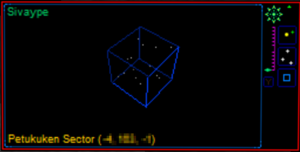Sector: Difference between revisions
Jump to navigation
Jump to search
m (Added a link to Supermassive Black Hole.) |
(Added a picture.) |
||
| (2 intermediate revisions by the same user not shown) | |||
| Line 1: | Line 1: | ||
[[File:Sector.png|thumb|right|A sector as seen on the [[Navigator_Station|navigator console]].]] | |||
Each [[galaxy]] is subdivided into cube shaped sectors that are 10x10x10 [[parsec]]s in size. | Each [[galaxy]] is subdivided into cube shaped sectors that are 10x10x10 [[parsec]]s in size. | ||
| Line 5: | Line 6: | ||
For example, coordinate (312,-2,1) is 312 sectors east, then 2 sectors south, then 1 sector up from the center of the galaxy. The center of each galaxy is (0,0,0), which contains a [[Supermassive_Black_Hole|supermassive black hole]]. | For example, coordinate (312,-2,1) is 312 sectors east, then 2 sectors south, then 1 sector up from the center of the galaxy. The center of each galaxy is (0,0,0), which contains a [[Supermassive_Black_Hole|supermassive black hole]]. | ||
Sectors contain [[Solar_System|solar system]]s and large scale astronomical phenomena, such as | Sectors contain [[Solar_System|solar system]]s and large scale astronomical phenomena, such as [[nebula]]e. | ||
==Quotes from patch notes== | |||
{{Collapsible | |||
| Related patch notes | |||
| 2 = [https://www.hazeron.com/mybb/showthread.php?tid=2122 '''2020-01-16: Empty Sectors'''] | |||
:Every sector has at least one solar system. That means you can go on forever outside the galaxy. | |||
::The number of solar systems in a sector is now allowed to reach zero when the star density of the galaxy reaches zero. Star density reaches zero outside the galaxy and it can reach zero in thin areas within the galaxy, creating starless voids. | |||
::You can travel through empty sectors. The star map will show a single "explored" dot at the center. ::That is where the ships present and energy emissions appear. | |||
::Star density is not allowed to reach zero at the core. There is always at least one solar system at the core. | |||
::Existing sectors and solar systems are not affected. | |||
}} | |||
[[Category:Science]] | [[Category:Science]] | ||
Latest revision as of 23:41, 8 March 2024

Each galaxy is subdivided into cube shaped sectors that are 10x10x10 parsecs in size.
The locations of sectors within a galaxy are expressed using the Cartesian coordinate system. An (X,Y,Z) coordinate specifies the location of a sector by its distance from the center of the galaxy, measured in sectors: positive X is east; negative X is west; positive Y is north; negative Y is south; positive Z is up; negative Z is down.
For example, coordinate (312,-2,1) is 312 sectors east, then 2 sectors south, then 1 sector up from the center of the galaxy. The center of each galaxy is (0,0,0), which contains a supermassive black hole.
Sectors contain solar systems and large scale astronomical phenomena, such as nebulae.
Quotes from patch notes
| Related patch notes |
|---|
2020-01-16: Empty Sectors
|